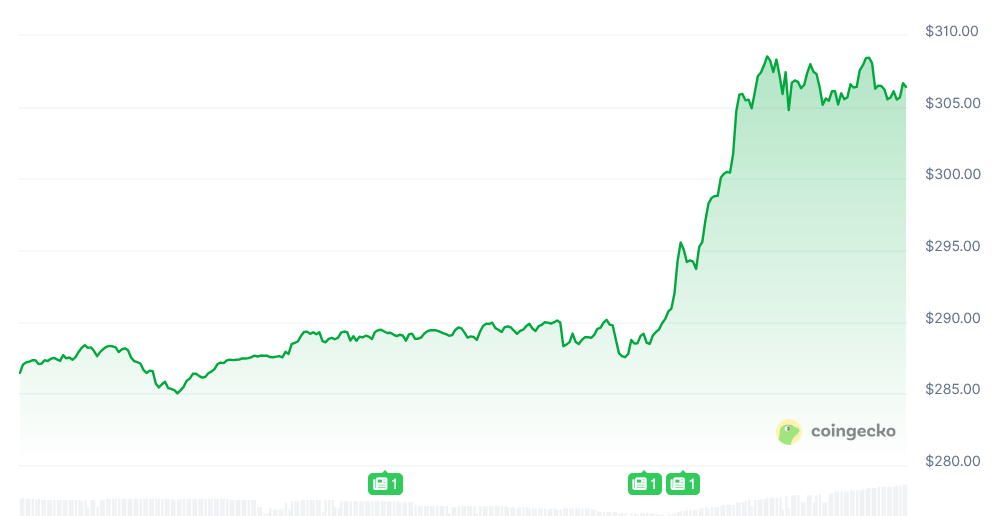Monero’s blockchain experienced an 18-block reorganization on September 14, 2025, reversing roughly 117 transactions after Qubic briefly controlled >51% of hashpower; XMR nevertheless rallied ~7.4% later that day. The event exposes persistent 51% risk and renewed debate over checkpointing and consensus changes.
-
18-block reorg reversed ~117 transactions
-
Qubic’s mining pool amassed >51% hashrate and triggered the reorg at block 3499659.
-
Despite the attack, XMR rose ~7.4% from $287.54 to $308.55 within hours (CoinGecko data).
Monero reorg: 18-block reorganization reversed 117 transactions after Qubic’s >51% hashpower; read defenses proposed and next steps to secure XMR. Read more on COINOTAG.
What is the Monero 18-block reorg?
The Monero 18-block reorg was a blockchain reorganization that began at block 3499659 on September 14, 2025 and concluded at block 3499676 about 43 minutes later. The event reversed approximately 117 transactions after Qubic briefly controlled more than 51% of Monero’s mining hashpower.
How did Qubic execute the reorg and what was reversed?
Node operators reported the reorg starting at 05:12 UTC and finishing roughly 43 minutes later. Community-run Monero nodes and a cryptocurrency protocol researcher named Rucknium confirmed the block reorganization activity in command-line logs and GitHub posts. Approximately 117 transactions were rolled back during the reorganized interval.

XMR’s change in price over the last 24 hours. Source: CoinGecko
Why did XMR’s price rise despite the attack?
XMR traded relatively flat during the reorg and later rallied about 7.4% from $287.54 to $308.55 on CoinGecko data. Market reaction suggests traders judged the incident as a solvable network governance or centralization problem rather than a terminal security failure.
What defensive options is the Monero community considering?
Monero developers and node operators have discussed several countermeasures to mitigate repeat 51% risks. Proposed options include temporary DNS checkpointing, consensus algorithm changes, merge-mining approaches, and adoption of chain-finality mechanisms like ChainLocks.
| Defense | Pros | Cons |
|---|---|---|
| DNS checkpoints | Quick deployment, immediate protection | Increases centralization, trust in DNS providers |
| Consensus overhaul (PoW changes) | Long-term resistance to centralized miners | Complex adoption, community coordination needed |
| Merge-mining / ChainLocks | Improves finality, leverages stronger networks | Technical integration and incentives challenges |
What are community reactions and expert commentary?
Community commentary ranged from calls to temporarily stop accepting XMR for payments to suggestions that Qubic may have been experimenting with price-support mechanisms. Security firm founder Yu Xian warned that ignoring reorgs leaves Monero vulnerable, while crypto podcasters and node operators shared logs and analysis publicly on X platforms and GitHub.
Frequently Asked Questions
How many transactions were reversed in the Monero reorg?
About 117 transactions were reversed during the 18-block reorganization that ran from block 3499659 to 3499676, according to node operator logs and researcher reports on GitHub.
Is Monero safe to use after the reorg?
The reorg exposed a realistic 51% risk while a single actor held majority hashpower. Short-term safety depends on community mitigations; many services may temporarily pause XMR payments until stronger protections are in place.
Key Takeaways
- Reorg magnitude: An 18-block reorganization reversed ~117 transactions, exceeding the network’s 10-block lock protection.
- Centralization risk: Qubic’s >51% hashpower highlights continued vulnerability in PoW networks that lack widespread mining decentralization.
- Next steps: The community is weighing DNS checkpoints, consensus tweaks, and finality solutions; coordination and testing are required for safe rollout.
Conclusion
The Monero 18-block reorg underscores the persistent threat of concentrated hashpower and the practical trade-offs between decentralization and immediate protection. COINOTAG will continue to monitor developer discussions, node operator actions, and community proposals as Monero considers DNS checkpoints, consensus changes, and finality mechanisms to restore confidence in XMR.
Sources: node operator command-line logs shared on X platforms, GitHub researcher Rucknium, CoinGecko price data, and community comments from X users and security practitioners (Yu Xian, Vini Barbosa, podcasters and researchers).
